Phân tích định lượng các nguyên tố vết trong cây artichoke tại thành phố đà lạt sử dụng phương pháp huỳnh quang tia X phản xạ toàn phần
Artichoke là loại rau đặc biệt tại thành phố Đà Lạt, nó cung cấp rất nhiều chất dinh dưỡng
và khoáng chất. Trong nghiên cứu này, cây Artichoke được thu thập tại hai vùng Artichoke
ở phường 12 thành phố Đà Lạt từ ngày 02 đến ngày 16 tháng 02 năm 2020. Những phần
Artichoke được sử dụng trong nghiên cứu gồm: Hoa, lá, thân, và rễ. Mười hai mẫu artichoke
đã được thu thập với ba mẫu cho từng bộ phận. Kỹ thuật huỳnh quang tia X (TXRF) đã được
sử dụng trong nghiên cứu–đây là kỹ thuật thường sử dụng trong phân tích định tính và định
lượng của các nguyên tố trong các loại mẫu: Rắn, lỏng, và khí. TXRF có nhiều ưu điểm như
phân tích đơn giản, phân tích nhanh, phân tích đồng thời nhiều nguyên tố, mẫu mỏng, và
không bị hiệu ứng matrix. Mục đích của nghiên cứu này là xác định nồng độ các nguyên tố
trong các phần của cây Artichoke. Kết quả đã xác định được 11 nguyên tố vết, bao gồm: P,
K, Ca, Mn, Fe, Cu, Zn, As, Cd, Hg, và Pb. So sánh với các nghiên cứu trước đây, hầu hết
hàm lượng các nguyên tố này là tương đồng với số liệu trước, ngoại trừ nguyên tố Cadmium
có hàm lượng cao hơn đáng kể.
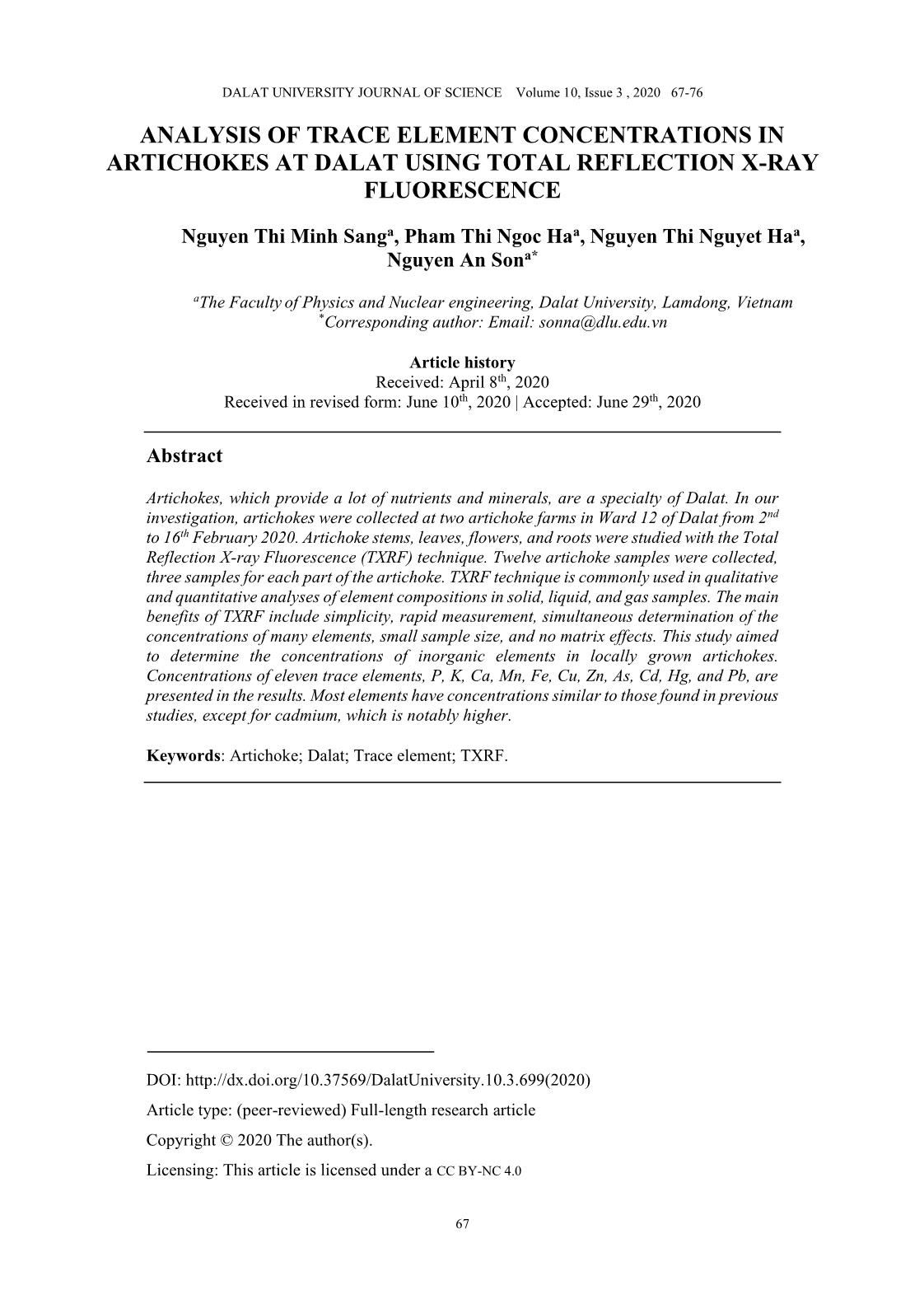
Trang 1
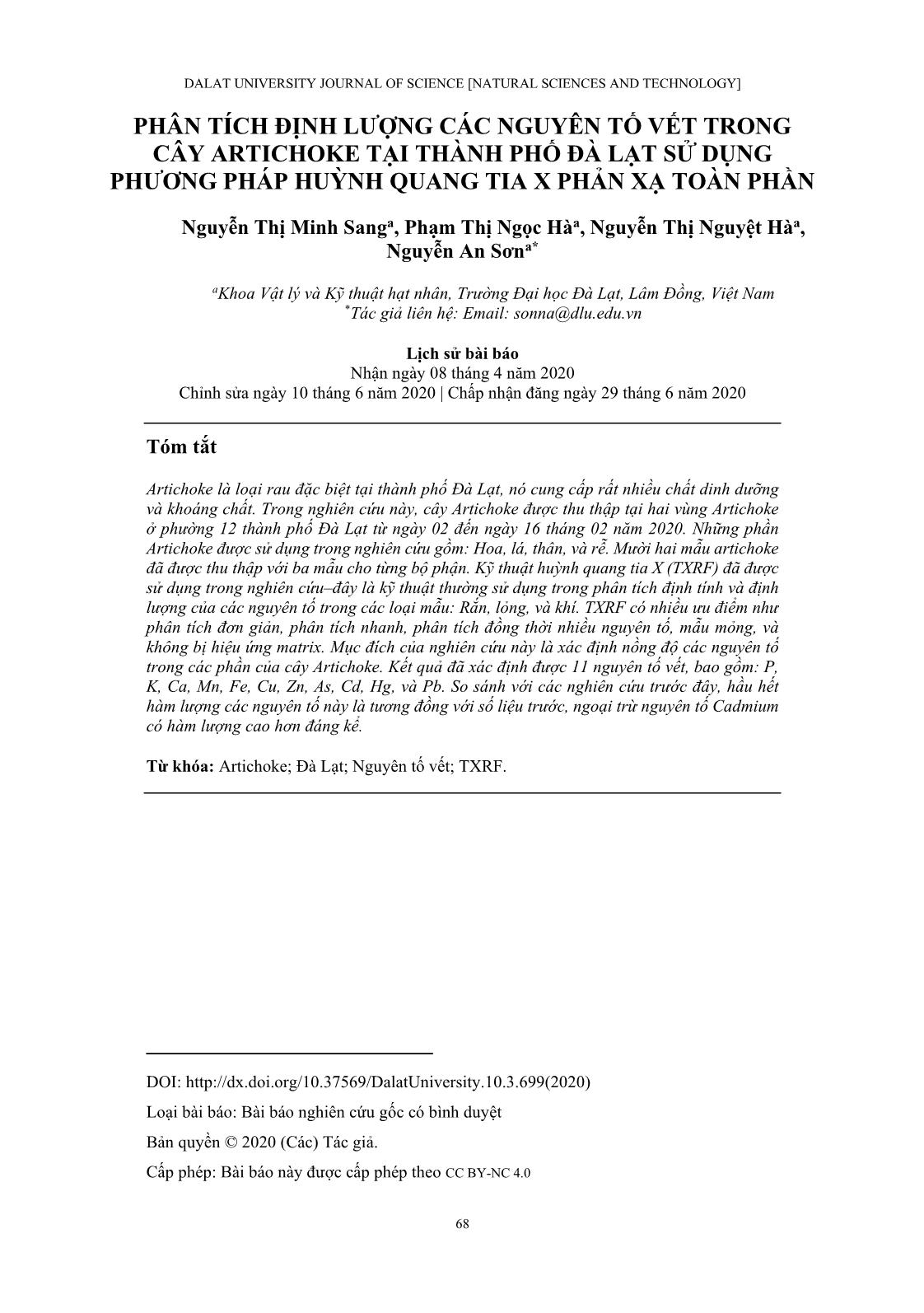
Trang 2
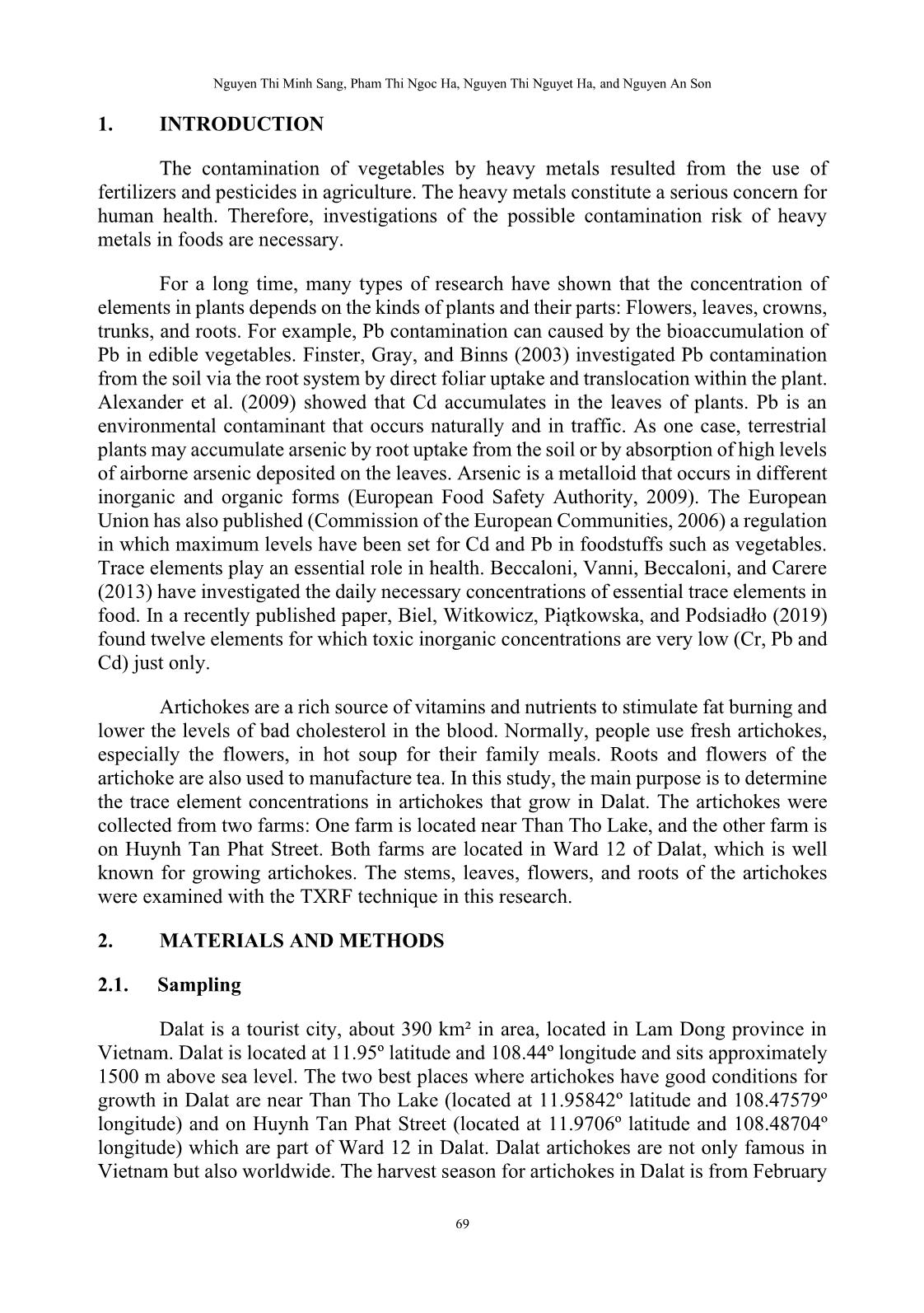
Trang 3
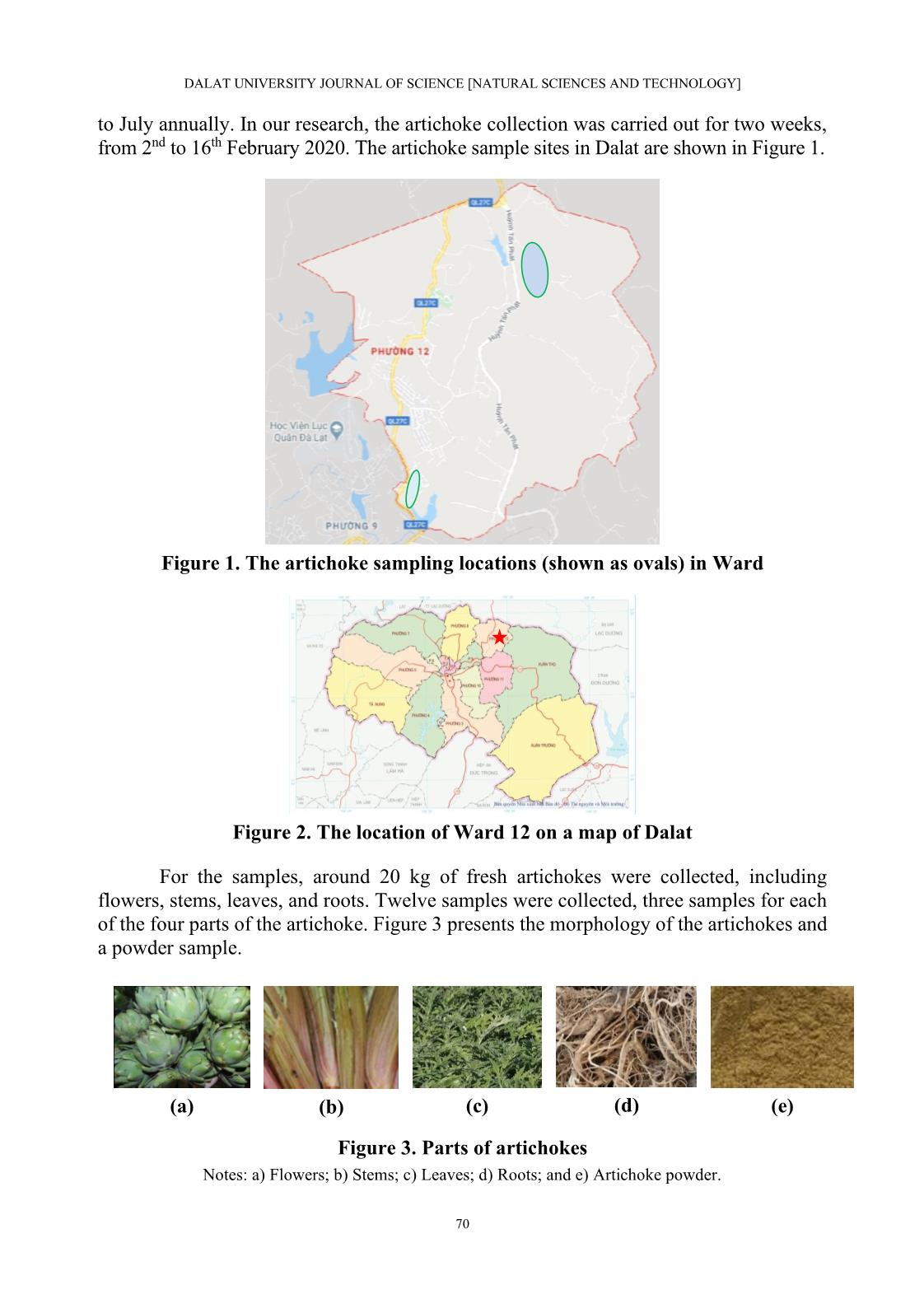
Trang 4
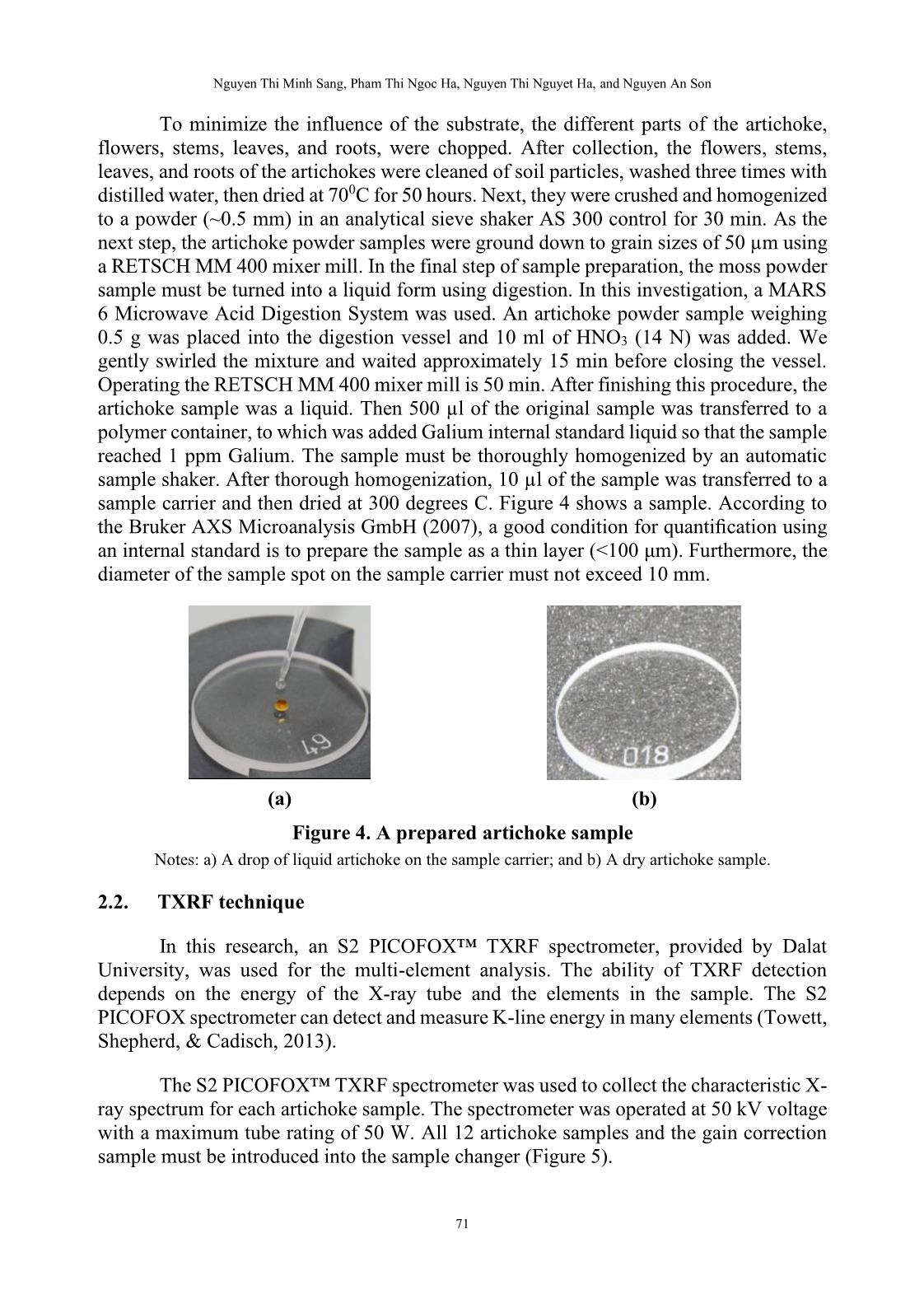
Trang 5
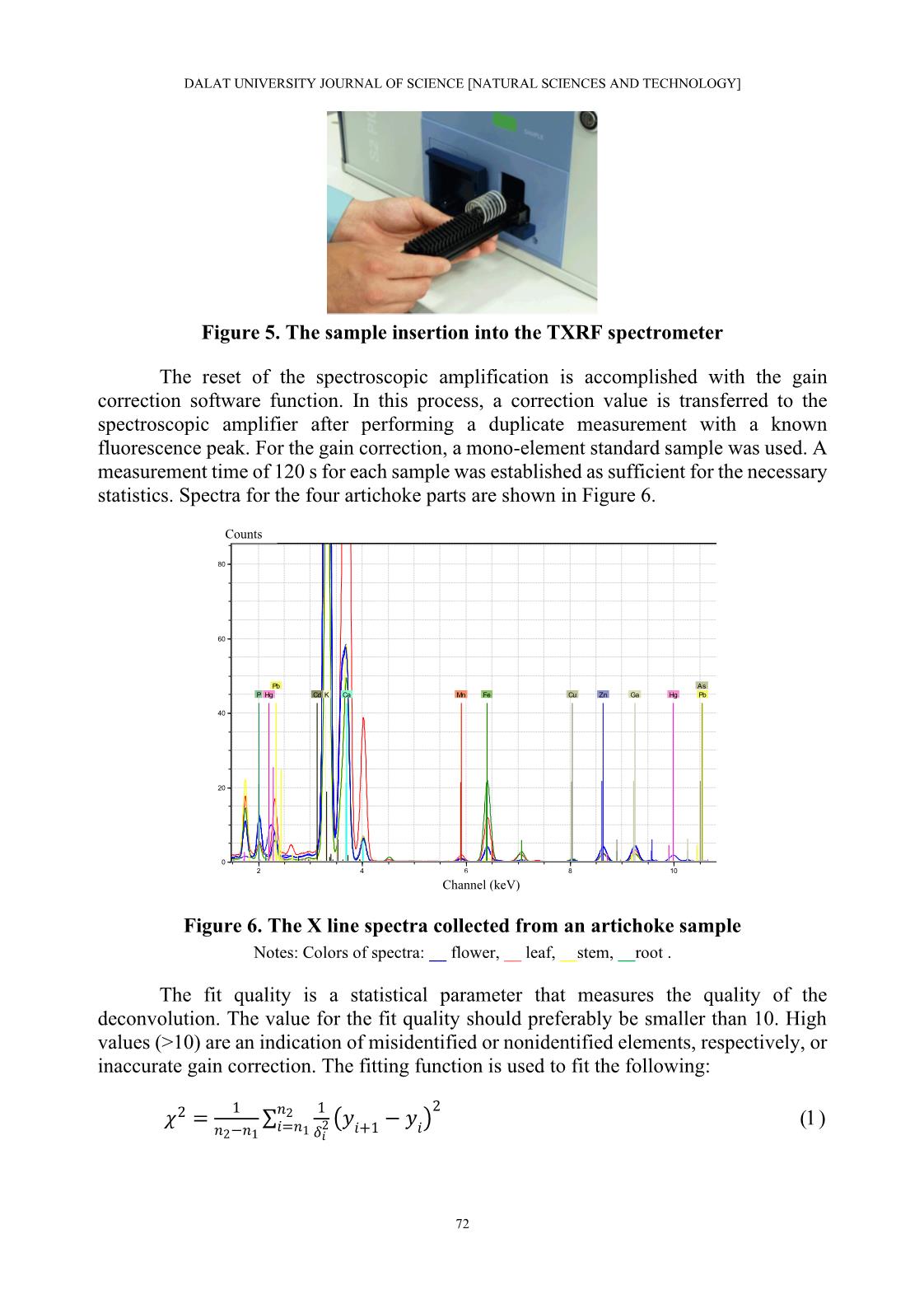
Trang 6
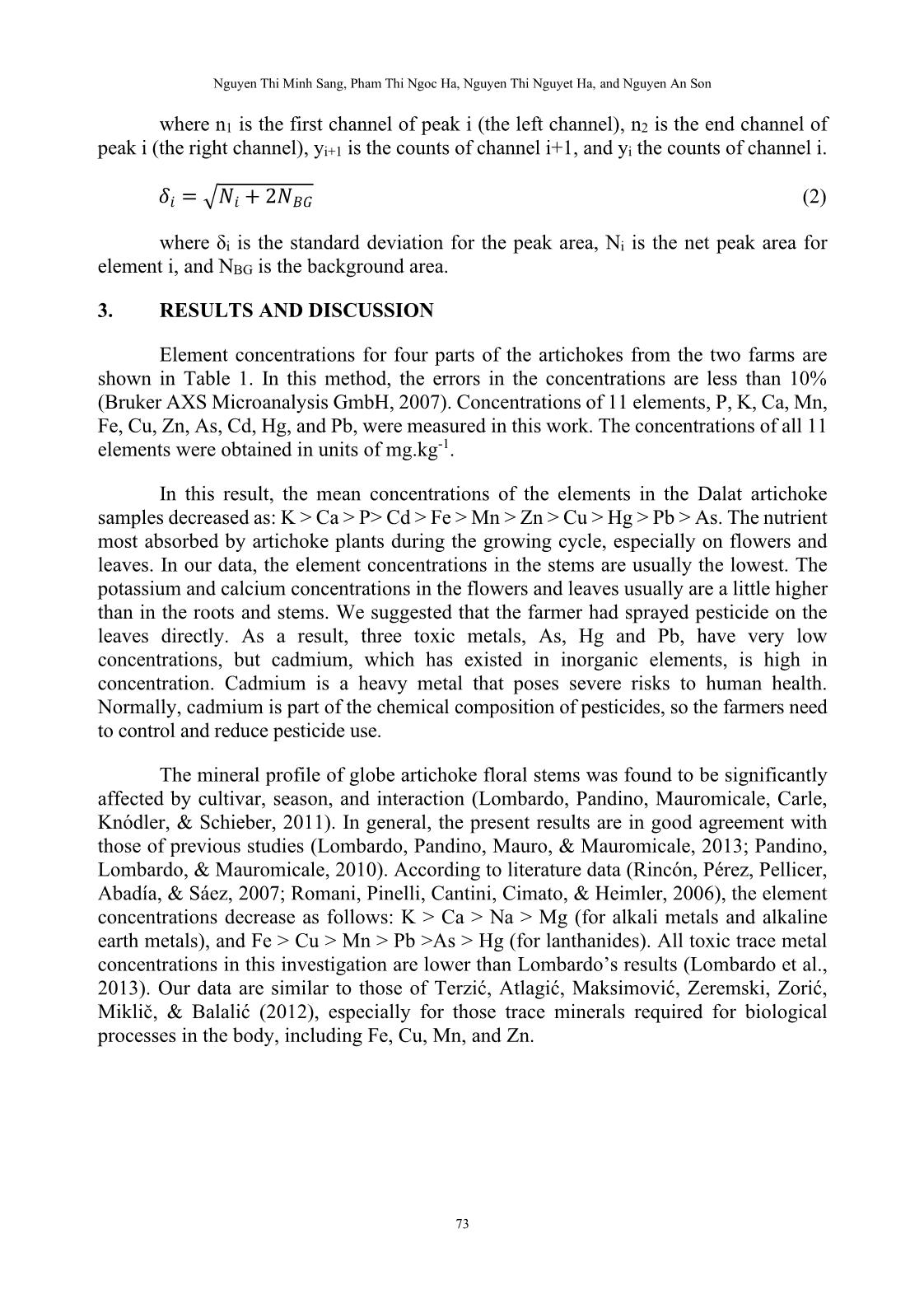
Trang 7
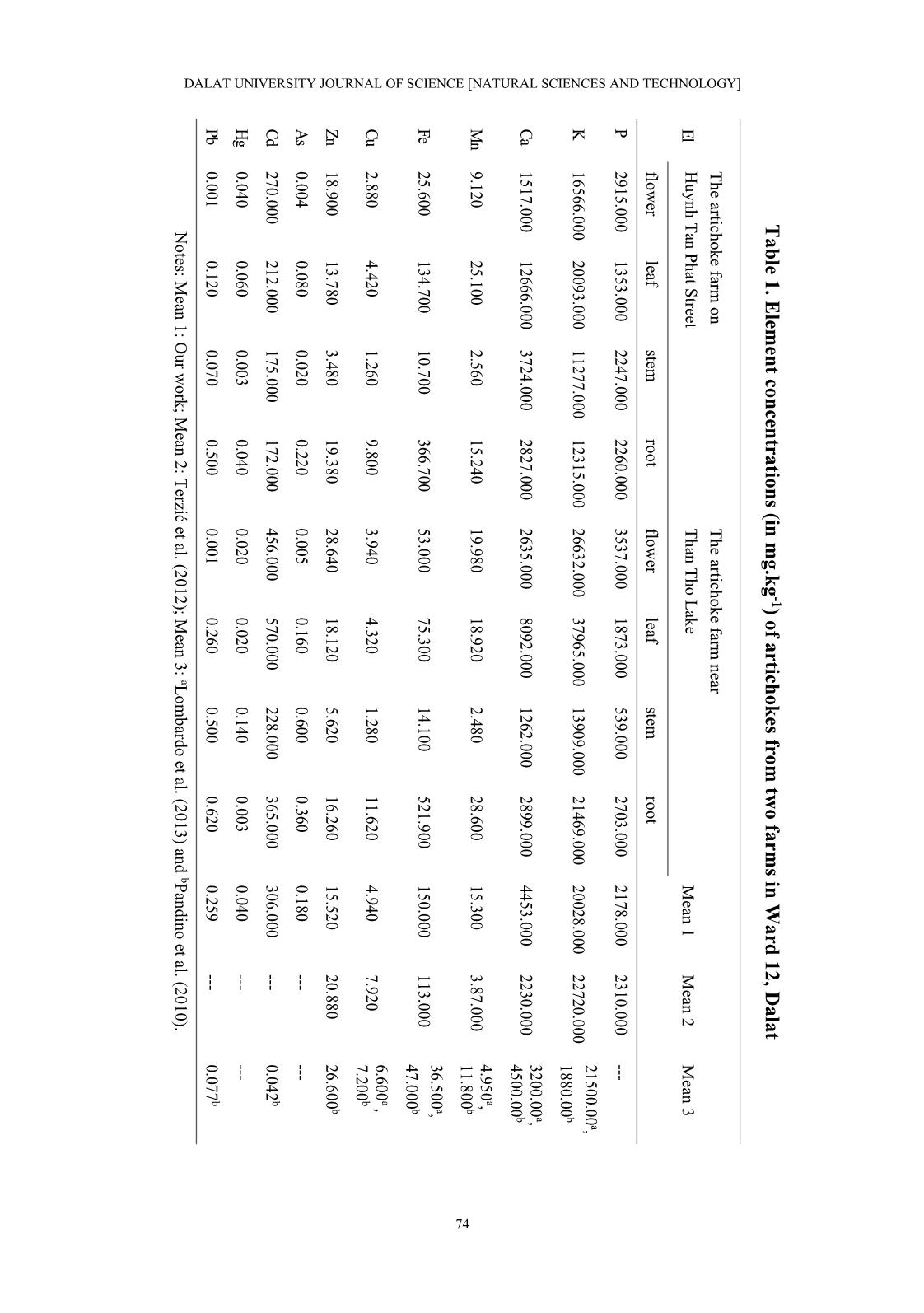
Trang 8
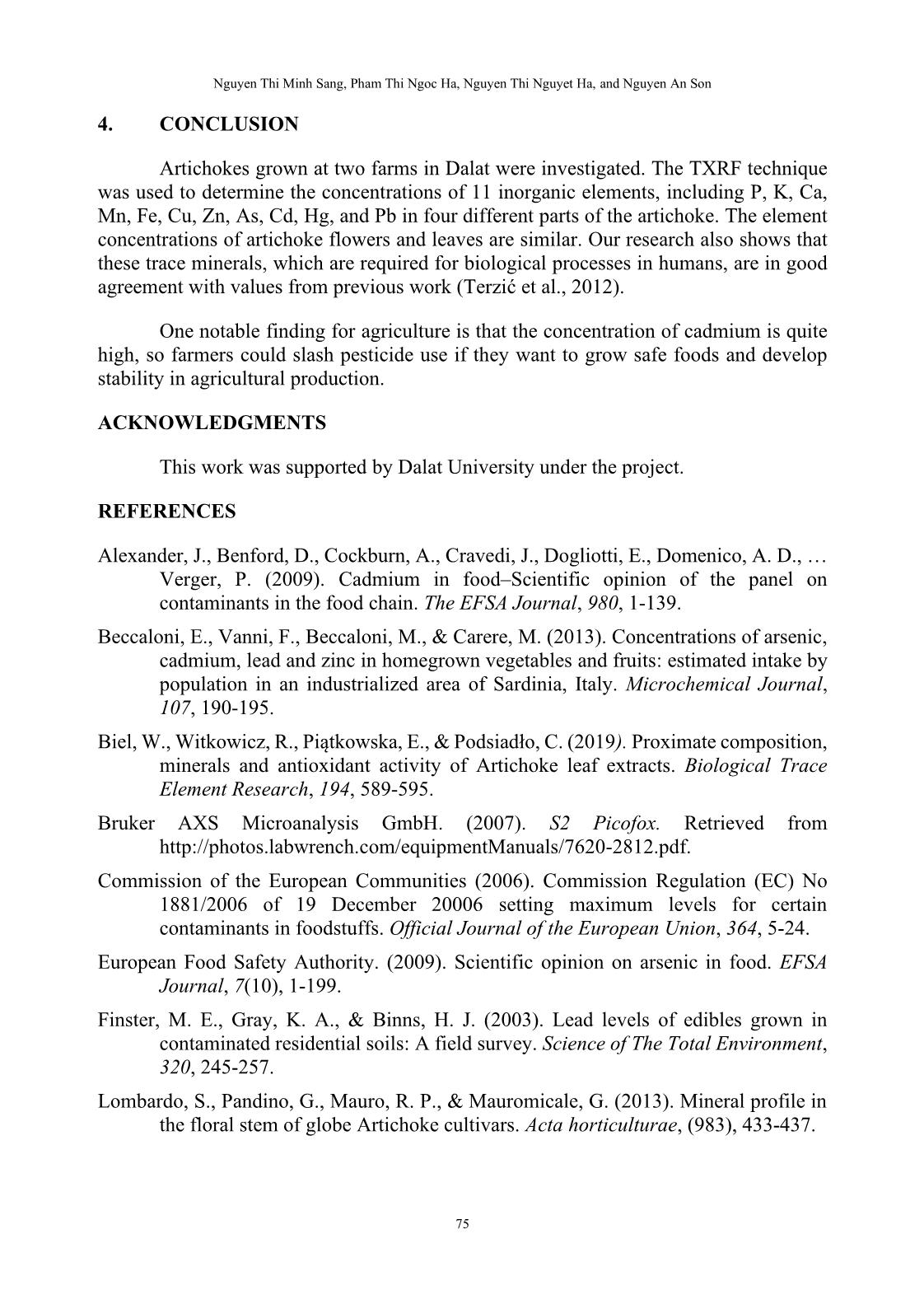
Trang 9
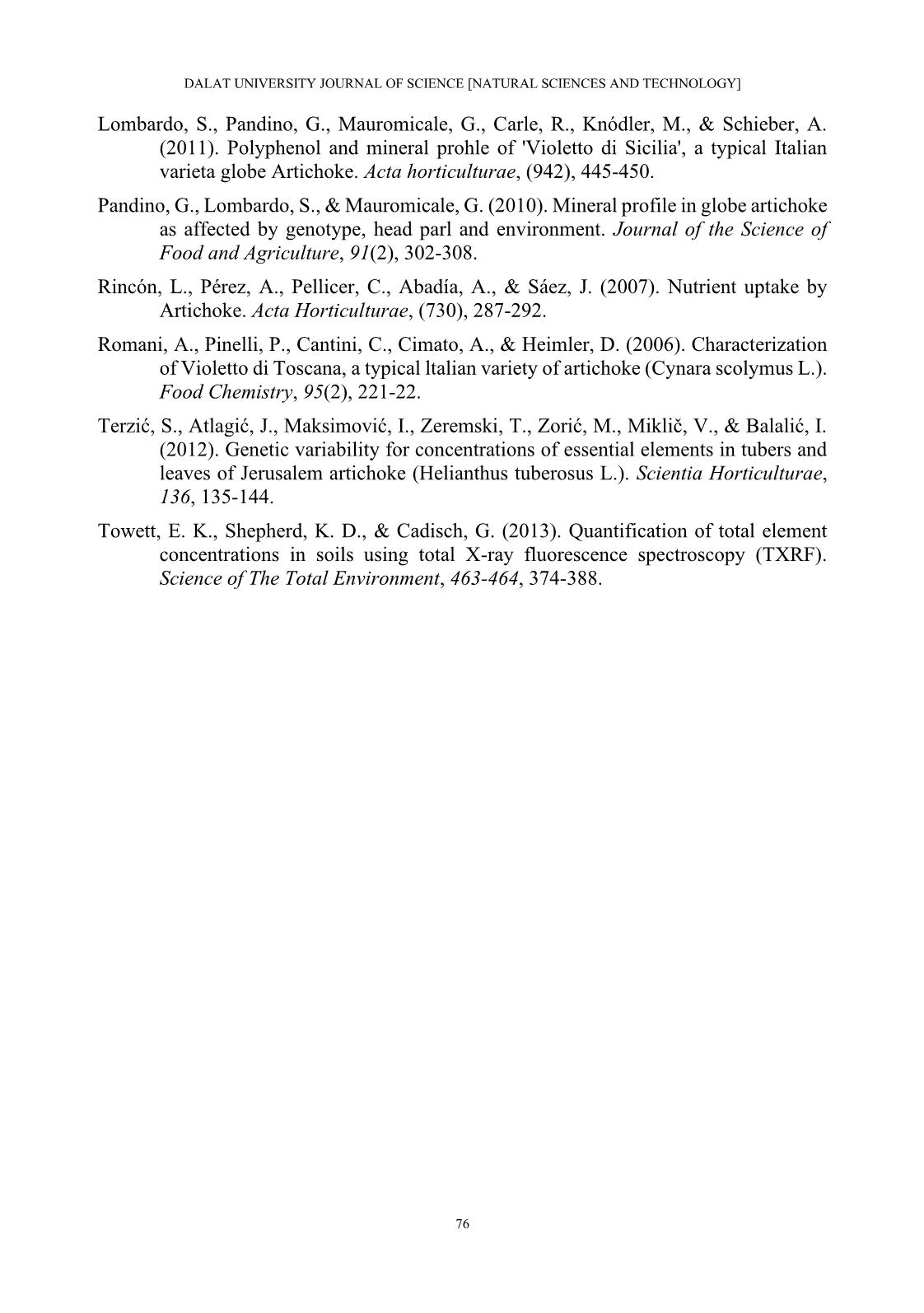
Trang 10
Tóm tắt nội dung tài liệu: Phân tích định lượng các nguyên tố vết trong cây artichoke tại thành phố đà lạt sử dụng phương pháp huỳnh quang tia X phản xạ toàn phần
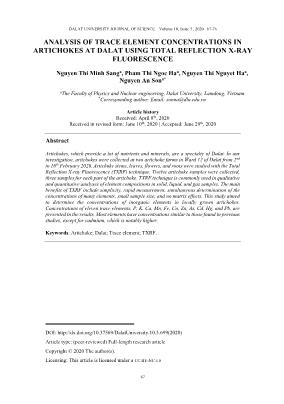
f research have shown that the concentration of elements in plants depends on the kinds of plants and their parts: Flowers, leaves, crowns, trunks, and roots. For example, Pb contamination can caused by the bioaccumulation of Pb in edible vegetables. Finster, Gray, and Binns (2003) investigated Pb contamination from the soil via the root system by direct foliar uptake and translocation within the plant. Alexander et al. (2009) showed that Cd accumulates in the leaves of plants. Pb is an environmental contaminant that occurs naturally and in traffic. As one case, terrestrial plants may accumulate arsenic by root uptake from the soil or by absorption of high levels of airborne arsenic deposited on the leaves. Arsenic is a metalloid that occurs in different inorganic and organic forms (European Food Safety Authority, 2009). The European Union has also published (Commission of the European Communities, 2006) a regulation in which maximum levels have been set for Cd and Pb in foodstuffs such as vegetables. Trace elements play an essential role in health. Beccaloni, Vanni, Beccaloni, and Carere (2013) have investigated the daily necessary concentrations of essential trace elements in food. In a recently published paper, Biel, Witkowicz, Piątkowska, and Podsiadło (2019) found twelve elements for which toxic inorganic concentrations are very low (Cr, Pb and Cd) just only. Artichokes are a rich source of vitamins and nutrients to stimulate fat burning and lower the levels of bad cholesterol in the blood. Normally, people use fresh artichokes, especially the flowers, in hot soup for their family meals. Roots and flowers of the artichoke are also used to manufacture tea. In this study, the main purpose is to determine the trace element concentrations in artichokes that grow in Dalat. The artichokes were collected from two farms: One farm is located near Than Tho Lake, and the other farm is on Huynh Tan Phat Street. Both farms are located in Ward 12 of Dalat, which is well known for growing artichokes. The stems, leaves, flowers, and roots of the artichokes were examined with the TXRF technique in this research. 2. MATERIALS AND METHODS 2.1. Sampling Dalat is a tourist city, about 390 km² in area, located in Lam Dong province in Vietnam. Dalat is located at 11.95º latitude and 108.44º longitude and sits approximately 1500 m above sea level. The two best places where artichokes have good conditions for growth in Dalat are near Than Tho Lake (located at 11.95842º latitude and 108.47579º longitude) and on Huynh Tan Phat Street (located at 11.9706º latitude and 108.48704º longitude) which are part of Ward 12 in Dalat. Dalat artichokes are not only famous in Vietnam but also worldwide. The harvest season for artichokes in Dalat is from February DALAT UNIVERSITY JOURNAL OF SCIENCE [NATURAL SCIENCES AND TECHNOLOGY] 70 to July annually. In our research, the artichoke collection was carried out for two weeks, from 2nd to 16th February 2020. The artichoke sample sites in Dalat are shown in Figure 1. Figure 1. The artichoke sampling locations (shown as ovals) in Ward Figure 2. The location of Ward 12 on a map of Dalat For the samples, around 20 kg of fresh artichokes were collected, including flowers, stems, leaves, and roots. Twelve samples were collected, three samples for each of the four parts of the artichoke. Figure 3 presents the morphology of the artichokes and a powder sample. (a) (b) (c) (d) (e) Figure 3. Parts of artichokes Notes: a) Flowers; b) Stems; c) Leaves; d) Roots; and e) Artichoke powder. Nguyen Thi Minh Sang, Pham Thi Ngoc Ha, Nguyen Thi Nguyet Ha, and Nguyen An Son 71 To minimize the influence of the substrate, the different parts of the artichoke, flowers, stems, leaves, and roots, were chopped. After collection, the flowers, stems, leaves, and roots of the artichokes were cleaned of soil particles, washed three times with distilled water, then dried at 700C for 50 hours. Next, they were crushed and homogenized to a powder (~0.5 mm) in an analytical sieve shaker AS 300 control for 30 min. As the next step, the artichoke powder samples were ground down to grain sizes of 50 µm using a RETSCH MM 400 mixer mill. In the final step of sample preparation, the moss powder sample must be turned into a liquid form using digestion. In this investigation, a MARS 6 Microwave Acid Digestion System was used. An artichoke powder sample weighing 0.5 g was placed into the digestion vessel and 10 ml of HNO3 (14 N) was added. We gently swirled the mixture and waited approximately 15 min before closing the vessel. Operating the RETSCH MM 400 mixer mill is 50 min. After finishing this procedure, the artichoke sample was a liquid. Then 500 µl of the original sample was transferred to a polymer container, to which was added Galium internal standard liquid so that the sample reached 1 ppm Galium. The sample must be thoroughly homogenized by an automatic sample shaker. After thorough homogenization, 10 µl of the sample was transferred to a sample carrier and then dried at 300 degrees C. Figure 4 shows a sample. According to the Bruker AXS Microanalysis GmbH (2007), a good condition for quantification using an internal standard is to prepare the sample as a thin layer (<100 μm). Furthermore, the diameter of the sample spot on the sample carrier must not exceed 10 mm. (a) (b) Figure 4. A prepared artichoke sample Notes: a) A drop of liquid artichoke on the sample carrier; and b) A dry artichoke sample. 2.2. TXRF technique In this research, an S2 PICOFOX™ TXRF spectrometer, provided by Dalat University, was used for the multi-element analysis. The ability of TXRF detection depends on the energy of the X-ray tube and the elements in the sample. The S2 PICOFOX spectrometer can detect and measure K-line energy in many elements (Towett, Shepherd, & Cadisch, 2013). The S2 PICOFOX™ TXRF spectrometer was used to collect the characteristic X- ray spectrum for each artichoke sample. The spectrometer was operated at 50 kV voltage with a maximum tube rating of 50 W. All 12 artichoke samples and the gain correction sample must be introduced into the sample changer (Figure 5). DALAT UNIVERSITY JOURNAL OF SCIENCE [NATURAL SCIENCES AND TECHNOLOGY] 72 Figure 5. The sample insertion into the TXRF spectrometer The reset of the spectroscopic amplification is accomplished with the gain correction software function. In this process, a correction value is transferred to the spectroscopic amplifier after performing a duplicate measurement with a known fluorescence peak. For the gain correction, a mono-element standard sample was used. A measurement time of 120 s for each sample was established as sufficient for the necessary statistics. Spectra for the four artichoke parts are shown in Figure 6. Figure 6. The X line spectra collected from an artichoke sample Notes: Colors of spectra: __ flower, __ leaf, __stem, __root . The fit quality is a statistical parameter that measures the quality of the deconvolution. The value for the fit quality should preferably be smaller than 10. High values (>10) are an indication of misidentified or nonidentified elements, respectively, or inaccurate gain correction. The fitting function is used to fit the following: 𝜒2 = 1 𝑛2−𝑛1 ∑ 1 𝛿𝑖 2 (𝑦𝑖+1 − 𝑦𝑖) 2𝑛2 𝑖=𝑛1 () 2 4 6 8 10 - keV - 0 20 40 60 80 x 1E3 Pulses Ga Ga P P K K Ca Ca Mn Mn Fe Fe Zn Zn Cu Cu Cd Cd Cd Hg Hg Hg Pb Pb Pb As As Channel (keV) Counts Nguyen Thi Minh Sang, Pham Thi Ngoc Ha, Nguyen Thi Nguyet Ha, and Nguyen An Son 73 where n1 is the first channel of peak i (the left channel), n2 is the end channel of peak i (the right channel), yi+1 is the counts of channel i+1, and yi the counts of channel i. 𝛿𝑖 = √𝑁𝑖 + 2𝑁𝐵𝐺 (2) where δi is the standard deviation for the peak area, Ni is the net peak area for element i, and NBG is the background area. 3. RESULTS AND DISCUSSION Element concentrations for four parts of the artichokes from the two farms are shown in Table 1. In this method, the errors in the concentrations are less than 10% (Bruker AXS Microanalysis GmbH, 2007). Concentrations of 11 elements, P, K, Ca, Mn, Fe, Cu, Zn, As, Cd, Hg, and Pb, were measured in this work. The concentrations of all 11 elements were obtained in units of mg.kg-1. In this result, the mean concentrations of the elements in the Dalat artichoke samples decreased as: K > Ca > P> Cd > Fe > Mn > Zn > Cu > Hg > Pb > As. The nutrient most absorbed by artichoke plants during the growing cycle, especially on flowers and leaves. In our data, the element concentrations in the stems are usually the lowest. The potassium and calcium concentrations in the flowers and leaves usually are a little higher than in the roots and stems. We suggested that the farmer had sprayed pesticide on the leaves directly. As a result, three toxic metals, As, Hg and Pb, have very low concentrations, but cadmium, which has existed in inorganic elements, is high in concentration. Cadmium is a heavy metal that poses severe risks to human health. Normally, cadmium is part of the chemical composition of pesticides, so the farmers need to control and reduce pesticide use. The mineral profile of globe artichoke floral stems was found to be significantly affected by cultivar, season, and interaction (Lombardo, Pandino, Mauromicale, Carle, Knódler, & Schieber, 2011). In general, the present results are in good agreement with those of previous studies (Lombardo, Pandino, Mauro, & Mauromicale, 2013; Pandino, Lombardo, & Mauromicale, 2010). According to literature data (Rincón, Pérez, Pellicer, Abadía, & Sáez, 2007; Romani, Pinelli, Cantini, Cimato, & Heimler, 2006), the element concentrations decrease as follows: K > Ca > Na > Mg (for alkali metals and alkaline earth metals), and Fe > Cu > Mn > Pb >As > Hg (for lanthanides). All toxic trace metal concentrations in this investigation are lower than Lombardo’s results (Lombardo et al., 2013). Our data are similar to those of Terzić, Atlagić, Maksimović, Zeremski, Zorić, Miklič, & Balalić (2012), especially for those trace minerals required for biological processes in the body, including Fe, Cu, Mn, and Zn. DALAT UNIVERSITY JOURNAL OF SCIENCE [NATURAL SCIENCES AND TECHNOLOGY] 74 T a b le 1 . E lem en t co n cen tra tio n s (in m g .k g -1) o f a rtich o k es fro m tw o fa rm s in W a rd 1 2 , D a la t T h e artich o k e farm o n H u y n h T an P h at S treet T h e artich o k e farm n ear T h an T h o L ak e M ean 1 M ean 2 M ean 3 flo w er leaf stem ro o t flo w er leaf stem ro o t N o tes: M ean 1 : O u r w o rk ; M ean 2 : T erzić et al. (2 0 1 2 ); M ean 3 : aL o m b ard o et al. (2 0 1 3 ) an d bP an d in o et al. (2 0 1 0 ). Nguyen Thi Minh Sang, Pham Thi Ngoc Ha, Nguyen Thi Nguyet Ha, and Nguyen An Son 75 4. CONCLUSION Artichokes grown at two farms in Dalat were investigated. The TXRF technique was used to determine the concentrations of 11 inorganic elements, including P, K, Ca, Mn, Fe, Cu, Zn, As, Cd, Hg, and Pb in four different parts of the artichoke. The element concentrations of artichoke flowers and leaves are similar. Our research also shows that these trace minerals, which are required for biological processes in humans, are in good agreement with values from previous work (Terzić et al., 2012). One notable finding for agriculture is that the concentration of cadmium is quite high, so farmers could slash pesticide use if they want to grow safe foods and develop stability in agricultural production. ACKNOWLEDGMENTS This work was supported by Dalat University under the project. REFERENCES Alexander, J., Benford, D., Cockburn, A., Cravedi, J., Dogliotti, E., Domenico, A. D., Verger, P. (2009). Cadmium in food–Scientific opinion of the panel on contaminants in the food chain. The EFSA Journal, 980, 1-139. Beccaloni, E., Vanni, F., Beccaloni, M., & Carere, M. (2013). Concentrations of arsenic, cadmium, lead and zinc in homegrown vegetables and fruits: estimated intake by population in an industrialized area of Sardinia, Italy. Microchemical Journal, 107, 190-195. Biel, W., Witkowicz, R., Piątkowska, E., & Podsiadło, C. (2019). Proximate composition, minerals and antioxidant activity of Artichoke leaf extracts. Biological Trace Element Research, 194, 589-595. Bruker AXS Microanalysis GmbH. (2007). S2 Picofox. Retrieved from Commission of the European Communities (2006). Commission Regulation (EC) No 1881/2006 of 19 December 20006 setting maximum levels for certain contaminants in foodstuffs. Official Journal of the European Union, 364, 5-24. European Food Safety Authority. (2009). Scientific opinion on arsenic in food. EFSA Journal, 7(10), 1-199. Finster, M. E., Gray, K. A., & Binns, H. J. (2003). Lead levels of edibles grown in contaminated residential soils: A field survey. Science of The Total Environment, 320, 245-257. Lombardo, S., Pandino, G., Mauro, R. P., & Mauromicale, G. (2013). Mineral profile in the floral stem of globe Artichoke cultivars. Acta horticulturae, (983), 433-437. DALAT UNIVERSITY JOURNAL OF SCIENCE [NATURAL SCIENCES AND TECHNOLOGY] 76 Lombardo, S., Pandino, G., Mauromicale, G., Carle, R., Knódler, M., & Schieber, A. (2011). Polyphenol and mineral prohle of 'Violetto di Sicilia', a typical Italian varieta globe Artichoke. Acta horticulturae, (942), 445-450. Pandino, G., Lombardo, S., & Mauromicale, G. (2010). Mineral profile in globe artichoke as affected by genotype, head parl and environment. Journal of the Science of Food and Agriculture, 91(2), 302-308. Rincón, L., Pérez, A., Pellicer, C., Abadía, A., & Sáez, J. (2007). Nutrient uptake by Artichoke. Acta Horticulturae, (730), 287-292. Romani, A., Pinelli, P., Cantini, C., Cimato, A., & Heimler, D. (2006). Characterization of Violetto di Toscana, a typical ltalian variety of artichoke (Cynara scolymus L.). Food Chemistry, 95(2), 221-22. Terzić, S., Atlagić, J., Maksimović, I., Zeremski, T., Zorić, M., Miklič, V., & Balalić, I. (2012). Genetic variability for concentrations of essential elements in tubers and leaves of Jerusalem artichoke (Helianthus tuberosus L.). Scientia Horticulturae, 136, 135-144. Towett, E. K., Shepherd, K. D., & Cadisch, G. (2013). Quantification of total element concentrations in soils using total X-ray fluorescence spectroscopy (TXRF). Science of The Total Environment, 463-464, 374-388.
File đính kèm:
 phan_tich_dinh_luong_cac_nguyen_to_vet_trong_cay_artichoke_t.pdf
phan_tich_dinh_luong_cac_nguyen_to_vet_trong_cay_artichoke_t.pdf

